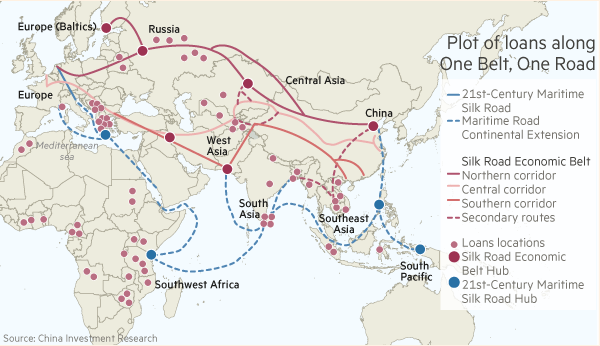This topic contains 4 replies, has 4 voices, and was last updated by ![]() Faust For Science 1 year, 8 months ago.
Faust For Science 1 year, 8 months ago.
- AuthorPosts
How China Became The World’s Number One International Financial Donor [1]
Valetin Katasonov
The Strategic Culture Foundation
May 5. 2018Professor Valentin Katasonov is a PhD. of Economic Sciences, Department of Moscow State Institute of International Finance and a member of the Russian Academy of Economics and Commerce. He was consultant of the United Nations (1991-1993), member of the Advisory Council to the President of the European Bank for Reconstruction and Development (EBRD) (1993-1996), head of the Department of International Monetary Relations of the Ministry of Foreign Affairs, Russia (2001-11).

At the spring meeting of the International Monetary Fund (IMF) and the World Bank (WB), the head of the US Treasury Department, Steven Mnuchin, touched upon a delicate subject: the financing of IMF and WB members by China and several other developing countries. He called these countries “non-transparent creditors” that do not coordinate their operations with the IMF, thereby destabilising the international loan market. Mnuchin noted that this practice creates problems for the debtor countries when it comes to the debt restructuring process.
These arguments are a cover for the US official’s barely disguised irritation at the fact that China is going against Washington’s usual way of doing things on the international loan market, where it has reigned supreme for many years and directed the market using the US-controlled International Monetary Fund. Steven Mnuchin then implied that Washington expected Beijing to coordinate its loan decisions for certain countries with the IMF.
Here are a few figures to give you some idea of just how worried Washington is by Beijing’s active involvement in the international arena as a financial donor.
The information is taken from a study by the AidData research lab at the College of William & Mary in America in conjunction with experts from Harvard University in the US and Heidelberg University in Germany.
Data was gathered and analysed from a total of 4300 projects that received Chinese funding in 140 countries around the world. The time frame of the study is 2000–2014 (fifteen years). The total amount of funding these projects received from China during this time period was $350 billion, and the scale of the funding increased steadily over the fifteen years, from $2.6 billion in 2000 to $37.3 billion in 2014. The largest amount was $69.6 billion in 2009.
The amount of funding given to foreign countries under various arrangements by the United States during the same period equalled $394.6 billion. This figure is slightly higher than that of China, but one should keep in mind that the volume of US funding did not increase as sharply as China’s. In 2000, the US provided $13.4 billion in overseas loans, which increased to $29.4 billion by 2014. In the final four years (2011-2014), China was already consistently exceeding the US in terms of the amount of overseas funding.
There are qualitative differences between the international financing policies of China and the US. First of all, China focuses on credits and loans (repayable funding), with financial aid (non-repayable or partially repayable funding) playing a lesser role. For America, however, financial aid dominates.
The authors of the study categorise as financial aid those agreements and projects in which the share of the grant exceeds 25%, while repayable funding includes those agreements and projects in which the share of the grant is less than 25%. The researchers have categorised the agreements and projects involving China where it has not been possible to determine the share of the grant as vague finance.
The distribution of China’s international financing across the three categories for the entire period was (billions of USD):
financial aid – 81.1; repayable funding – 216.3; vague finance – 57.0.The structure of America’s international financing was (billions of USD):
financial aid – 366.4; repayable funding – 28.1.Thus financial aid accounted for 92.5% of America’s total international financing, but just 21% of China’s.

So how is it that China has managed to focus on repayable funding, i.e. loans? At the beginning of the 21st century, the country discovered a huge niche that wasn’t being filled by the loans of America, other Western countries, the IMF or the WB. Many developing countries of Asia, Africa and Latin America were in dire need of overseas funding, but were unable or did not want to meet the stringent conditions of the “Washington Consensus”. Washington’s approach was politically motivated, while Beijing’s was commercial.
Beijing declared a principle of non-intervention in the domestic affairs of the recipient countries, and it turned out to be more appealing than America’s so-called financial assistance that was like free cheese in a mousetrap. What’s more, in the 2000s China was issuing loans at 2.5 percent per annum (far more favourable terms than were being offered by the West).
In its external financing policy, China focuses on those industries and economic sectors of the recipient countries that directly or indirectly boost the Chinese economy.
So the distribution of China’s external financing according to industry and sector between 2000 and 2014 looks like this (billions of USD): energy – 134.1; transport and logistics – 88.8; mining and manufacturing, construction – 30.3; agriculture and forestry – 10.0; and other industries – 74.3.

The geography of China’s external financing is also interesting. The following countries were the main beneficiaries of financial aid (in billions of USD):
Cuba – 6.7; Côte d’Ivoire – 4.0; Ethiopia – 3.7; Zimbabwe – 3.6;
Cameroon – 3.4; Nigeria – 3.1; Tanzania – 3.0; Cambodia – 3.0; Sri Lanka – 2.8; and Ghana – 2.5. And here is the geographical distribution of China’s repayable funding (billions of dollars): Russia – 36.6; Pakistan – 16.3; Angola – 13.4; Laos – 11.0; Venezuela – 10.8; Turkmenistan – 10.1; Ecuador – 9.7; Brazil – 8.5; Sri Lanka – 8.2; and Kazakhstan – 6.7.As can be seen, Russia is the biggest recipient of Chinese money in the form of repayable loans (almost 17% of China’s total repayable funding).
The main recipients of Chinese money include countries that Beijing is planning to make (or has already made) key players in the transcontinental “One Belt, One Road” project. China is too heavily dependent on its eastern seacoast and the narrow Strait of Malacca near Singapore through which most of its imports and exports pass. As an example, more than 80 percent of the oil purchased by China passes through this strait.

he construction of trade routes through Pakistan and Central Asia increases China’s resilience to political and military pressure from Washington. The “Belt and Road” project will also allow Beijing to start using its enormous currency reserves (more than $3 trillion), provide Chinese businesses with orders, and support employment in the country.
According to some estimates, more than $300 billion has already been spent on the project. And in the coming decades, China plans to spend a further $1 trillion on the “Belt and Road” project, creating an extensive transport and logistics infrastructure in Eurasia within the next decade.
In recent years, the West has surrendered its position as a lender in many Asian, African and Latin American countries, which has weakened its political influence significantly. But most striking is the speed with which China has come to the forefront. At present, China is issuing more loans to developing countries than the World Bank, and yet in the 1980s and 1990s, China itself was the biggest recipient of loans from the World Bank and the Asian Development Bank.
China is investing large amounts of money in countries that, by Western standards, are considered to be, if not “pariahs”, then “despotic”, “corrupt” and so on, countries like Zimbabwe, North Korea, Niger, Angola, and Burma.
Ugandan President Yoweri Museveni has said he likes Chinese money because “the Chinese don’t ask too many questions and they come with big money, not small money”.
In North Korea, meanwhile, only 17 Chinese projects were discovered over the entire period, for which the total amount of funding was just $210 million. This picture may be incomplete, however, since information is highly classified.
In some countries there is intense competition for influence between the US and China.
Pakistan is a prime example. In 2014, Pakistan was the third largest recipient of US money (after Iraq and Afghanistan). In the same year, Pakistan was the second largest recipient of Chinese money after Russia.
In 2015, Beijing began to have an additional influence by way of the Asian Infrastructure Investment Bank (AIIB). The authorised capital of AIIB is $100 billion. China, India and Russia are the three biggest shareholders with 26.06, 7.5 and 5.92 percent of the voting power respectively.

As can be seen, China’s position is much stronger than, say, America’s position in the IMF and the organisations that make up the World Bank Group (the International Bank for Reconstruction and Development, the International Finance Corporation, and the International Development Association). America’s stake in these is around the 16-17% mark.
Beijing’s international finance activities should not be regarded as “anti-imperialist”, of course. In the countries that Beijing is starting to befriend, what is left of their local industry is crumbling under the pressure of cheap Chinese imports. The projects to develop deposits or build roads and other infrastructure facilities involve predominantly Chinese contractors and suppliers. As often as not, construction and other onsite work uses Chinese labour.
Finally, China is slowly introducing tougher conditions for lending money to other countries. The interest rate has risen from 2.5% to 5% per annum and there is already a sense that many countries will not only be unable to repay, but also to service their Chinese loans.
Beijing is not worried, however: the deposits, real estate, infrastructure facilities built using Chinese money, and businesses serve as collateral. So it will all belong to China in the end. Then the competitive struggle between Washington and Beijing will become fiercer than ever.
Valentin Katasonov
The Strategic Culture Foundation
Anonymous42 China buy up everything then kick you out!
China buy up everything then kick you out! Bye bye!

Anonymous42P.S.
On the old Westinghouse Electric plant in Springfield is a new something big and foreboding massive building tens of thousands of sq ft. I saw it yesterday, It looked like something reminiscent of a soilent green plant, massive gates, and the kind of fence that stops bulldozers and dices small aircraft should one crash land.
Way back behind the gate and security building was three flags, Massachusetts, USA, and China. Seeing that threw me back in my seat, first Chinese flag I saw planted in American soil was planted in the carcass of Westinghouse Electric.
There’s allot of irony in what I saw yesterday, and I’m only beginning to see the tip of it.




Anonymous12And how did China even go from being a peasant country in the 40’s to a superpower? F~~~ing Europeans building them up.
And how did China even go from being a peasant country in the 40’s to a superpower? F~~~ing Europeans building them up.
The U.S. government had a hand. Nixon, Carter, Reagan, both Bushes, the Clintons, and Obama. All of them handed China the U.S. manufacturing industries. Also, the Clintons handed China nuclear other top secret weapons information.
The reason NAFTA talks are stalled is because China uses Mexico and Canada are economic proxies against the U.S.
- AuthorPosts
You must be logged in to reply to this topic.

921526
921524
919244
916783
915526
915524
915354
915129
914037
909862
908811
908810
908500
908465
908464
908300
907963
907895
907477
902002
901301
901106
901105
901104
901024
901017
900393
900392
900391
900390
899038
898980
896844
896798
896797
895983
895850
895848
893740
893036
891671
891670
891336
891017
890865
889894
889741
889058
888157
887960
887768
886321
886306
885519
884948
883951
881340
881339
880491
878671
878351
877678













